History
The origins of Villapizzone traditionally traces back to the 6th century, when a saintly Greek monk named Atanasio Piccione settled down in a forest and began to lead a community of Greek friars. The place was named Villaggio Piccione or Villa Piccione, hence Villapizzone. According to Giacomo Stella, who was the dean of the local church of San Martino in 1530, the friars initially deforested an area to cultivate it, then they built a little village consisting of some farmhouse and a church.
Documented references to the comune of Villapizzone date back at least to 1346. In the Late Middle Ages and until the 18th century, the comune used to be part of the pieve of Trenno. During Napoleonic rule, in 1808, Villapizzone was annexed to Milan, but regained its autonomy in 1816 with the establishment of the Kingdom of Lombardy–Venetia. In 1869 the comune was annexed to Musocco, which in turn became part of Milan municipality in 1923. Historical documents attest that, at that time, Villapizzone had its own cemetery, which was later dismantled.
The core of the village was the parish church of San Martino, in front of which was built a villa, owned by the noble Radice Fossati family. A woodland, which was initially a portion of the ancient Bosco della Merlata, was located in the area, and some of the trees that belonged to the forest are now beside of Via Paolo Mantegazza, in what is now the yard of the Goffredo Mameli elementary school.
Villapizzone remained a rural district until World War II; thereafter, it became part of a seamless residential area that includes Bovisa, Quarto Oggiaro and several other districts. The toponym "Villapizzone" itself was scarcely used for several decades; it reappeared in the late 20th century as a consequence of the construction of the station of the same name.

The Passante Ferroviario di Milano is an underground railway which runs through Milan, Italy.
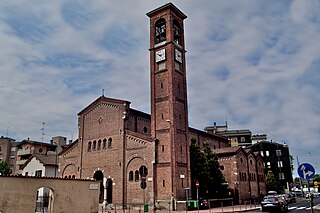
Lambrate is a district (quartiere) of Milan, Italy, located within the Zone 3 administrative division, six km (3.7 mi) north-east of the city centre. It owes its name to the Lambro river that traverses the area. Lambrate houses one of the major railway stations of north-eastern Milan, the Stazione di Milano Lambrate. The district is also well known for Parco Lambro, a large urban park established in 1934. The famous Lambretta motor scooter was manufactured in Lambrate, and named after this district, as is Birrificio Lambrate, a craft brewery established in 1996.
Vigentino is a district ("quartiere") of Milan, Italy, part of the Zone 5 administrative division, located south of the city centre. Before 1923, Vigentino was an autonomous, rural comune. By the mid 20th century, agricultural activities were dismissed, and the area was largely urbanized, with the construction of large apartment blocks.
Vaiano Valle is a rural district ("quartiere") of Milan, Italy, part of the Zone 5 administrative division. It is located south of the city's urban area, within the Parco Agricolo Sud Milano nature reserve. Before 1869, it was an autonomous comune.
Figino is a district ("quartiere") of Milan, Italy, part of the Zone 7 administrative division. It is located north-west of the centre, within the Parco Agricolo Sud Milano nature reserve. Before being annexed to Milan, in 1869, it was an autonomous comune, named Figino di Milano.

Garegnano is a district ("quartiere") of Milan, Italy, part of the Zone 8 administrative division of the city, north-west of the city centre. Before being annexed to Milan, it has been an autonomous comune, originally known as Garegnano Marcido.

Quarto Oggiaro is a district of Milan in the north-west of the city. It belongs to Zone 8, and has a population of 35000 inhabitants.

Bovisa is a district (quartiere) of Milan, Italy, located north of the city center, in the Zone 9. The name is supposedly derived from the Italian word bove, meaning ox, as the area developed from an ancient rural settlement.
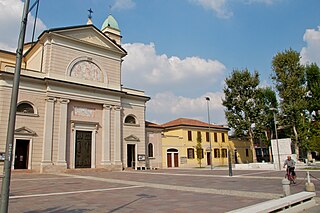
Affori is a ward of Milan, Italy, part of the Zone 9 administrative division of the city, located north of the city centre. It borders with the wards of Bruzzano, Comasina, Bovisasca, Dergano and Niguarda. Before being annexed to Milan in 1923, it was an autonomous comune.

The Zone 2 of Milan, since 2016 officially Municipality 2 of Milan, is one of the 9 administrative divisions of Milan, Italy.
Corpi Santi di Milano is a former Italian comune, established in 1782 and annexed to Milan in 1873. It comprised the rural territory around the city walls of Milan. It was originally known just as Corpi Santi; "di Milano" was added in 1859, possibly to avoid confusion with the comune with the same name located in the area of Pavia.

Milano Bovisa is a railway station in Bovisa, Milan, Italy. It opened in 1879 and is now one of the key nodes of the Milan suburban railway service, and of the Trenord regional network in northern Lombardy. It is located in Piazza Emilio Alfieri.

Milano Villapizzone is a surface railway station in Milan, Italy and serves the suburb of Villapizzone. It opened in 2002 as part of the Milan Passante railway. It is located on Via Arnaldo Fusinato.

The Zone 8 of Milan, since 2016 officially Municipality 8 of Milan, is one of the 9 administrative divisions of Milan, Italy.
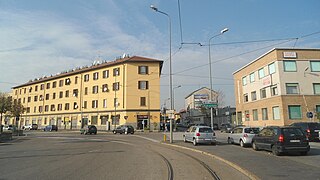
Quartiere Varesina is a small district, quartiere, of Milan, located in the suburban north-west part of the city. It belongs on the Zone 8 administrative division of the city.

The Zone 6 of Milan, since 2016 officially Municipality 6 of Milan, is one of the 9 administrative divisions of Milan, Italy.
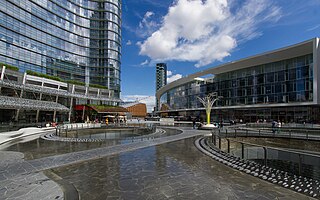
The Zone 9 of Milan, since 2016 officially Municipality 9 of Milan, is one of the 9 administrative divisions of Milan, Italy.
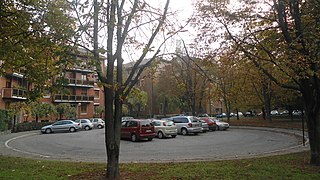
Quartiere Campo dei Fiori is a small district in Milan, Italy. The district measures 400 by 300 meters. It is located in the north-western outskirts of the city, and is a part of Zone 8.

The Milan–Asso railway is a regional railway line with standard track gauge which links Milan to Canzo crossing for Erba and other towns in Brianza. The most northern terminal is the station of Canzo-Asso, which is located in Canzo's territory but is also known as Asso in the short form. That, because there is another station on the line called Canzo station and Canzo-Asso is next to Asso's boundary and serves this commune too.
Musocco is a district of Milan, located in the north-western outskirts of the city, belonging to Zone 8.















